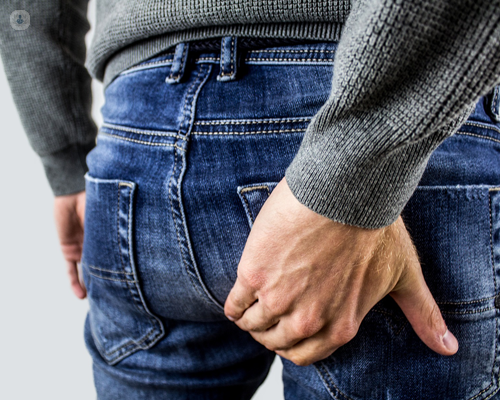Pain in the posterior? An expert’s guide to addressing haemorrhoids
Autore:The pain and discomfort caused by enlarged piles are very common but no less aggravating. They impact quality of life at whatever stage they’re at, but the more severe degrees can lead to operative treatment.
Leading consultant colorectal surgeon Professor Puthucode Haray breaks down exactly what haemorrhoids are, associated symptoms and what’s involved in treatment for each degree of the condition, in this comprehensive and useful article.

What are haemorrhoids?
Haemorrhoids (also commonly known as piles) are cushions found at the junction of the bowel with the anus (back passage). This marks the area between the sensitive skin and the start of the bowel lining, which is not sensitive to pain as there are no nerve endings in the bowel wall.
These haemorrhoidal cushions help with maintaining continence. By increasing the blood supply to them we can enlarge the size of the cushions, especially when we cough, helping us to hold gas and stool. This means they are an important part of our method to maintain control of our bowels.
These cushions can become enlarged, initially inside the back passage in the early stages and then gradually start coming down when straining to pass motions. As they start coming down, they progress to becoming internal and external and may need to pushed back up. Eventually, the lumps may reach a stage where they remain permanently outside.
What are the symptoms of haemorrhoids?
- Bleeding from the rectum (back passage) - fresh, bright red blood
- Discomfort and itchy anus - and around the area
- Lumps (swellings) around the back passage
Many of these symptoms can also be present in more serious bowel conditions such as colitis, Crohn’s disease or bowel cancer. Therefore, if you have any of these symptoms, please get them checked out by your GP or a specialist.
Who are the people most at risk of developing haemorrhoids?
- People who are constipated and strain to pass stools
- Obese or overweight people
- Diet low in fibre
- Heavy lifting jobs
- During pregnancy or after childbirth
What are the treatments for haemorrhoids? Is an operation always necessary?
Treatment depends on the degree (stage) of the haemorrhoids. Usually these are described as first to fourth degree.
First degree
Early stages can be managed with conservative (lifestyle) techniques which include:
- High fibre diet
- Good fluid intake
- Bowels should be opened whenever the urge to pass a motion rather than ‘holding it in’ for hours or days
- Regular exercise
- Avoidance of excessive caffeine/alcohol
Second degree
Sometimes medications may be needed such as:
- Laxatives - to soften the stools to make them easier to pass
- Creams or ointments - to help with the itching, pain or swelling
- Cold compresses - to help reduce the swelling
Third degree
If the above treatments are not effective or the haemorrhoids are at an advanced stage, procedures or operations may be required:
- Injection of a special chemical or placing tiny rubber bands on haemorrhoids can be tried and can often be done without anaesthetic in the outpatient clinic, though they can be quite uncomfortable. Often, these techniques give only short-term relief.
- Operations - there are a variety of these which are best done under a full anaesthetic and include:
- Laser treatment - suitable for relatively early haemorrhoids but do have a higher risk of recurrence
- Haemorrhoidal artery ligation under ultrasound control (commonly known as THD or HALO) where a special doppler probe is used to identify the feeding blood vessels high inside the back passage and tie them off so that the swollen blood vessels shrink and disappear. These are very effective in third degree and can even be used in some fourth-degree haemorrhoids.
- THD & HALO operations can often be combined with a ‘mucopexy’ operation - a kind of prolapse repair to hitch up the lumps coming down from the back passage. As the entire operation in carried out high inside the back passage where there no pain nerve endings and so there is much less pain after these operations compared to the traditional haemorrhoidectomy. Usually, these operations are offered as a day case without the need for overnight hospital stay.
- Some cases may need a full haemorrhoidectomy (removal of the haemorrhoids). This operation, though very effective can be very painful after the operation for a few weeks.
What is involved in postoperative recovery after a THD procedure?
The operation itself takes around one hour. After the operation, you will be taken to the recovery area in the operation theatre suite and then transferred back to the ward. You will feel drowsy for some time but be allowed to eat and drink within a few hours and allowed home later the same day, if you are pain free and once you have passed urine, etcetera. Occasionally, patients may need stay overnight, if they are very drowsy or experiencing pain.
You will usually be sent home with some laxatives, pain killers and advised to drink plenty of fluids and to keep the bowels easily open without straining for at least four to six weeks after the procedure. This is to allow time for the internal stitches to heal, as straining soon after the operation is more likely to cause a recurrence of the haemorrhoids. You should feel recovered and ready to resume normal activity within two to three days, on average. The affected areas return to their normal structure within two to three months.
More information and a patient perspective video can be accessed at: http://colorectaleducation.com/thd-patient/
What are the possible side effects or complications after haemorrhoid operations?
Haemorrhoid operations are relatively simple and quite straightforward. However, any operation that requires a general anaesthetic does carry some risk, which is dependent on the underlying health of the individual patient. These can include heart or lung disturbance as well as DVT (Deep Venous Thrombosis) or PE (clots in lungs). Appropriate precautions are routinely taken to minimise these risks, which are very rare.
Haemorrhoidectomy involves cutting the lumps away. This leaves wounds around the back passage which are usually left open, as stitching them closed would almost inevitably result in infections. These can take a few weeks to heal and hence it is common for patients to feel a considerable amount of pain for a couple of weeks which usually require regular painkillers. In addition, haemorrhoids are very close to the sphincter muscles around the back passage which can get damaged, despite due care during surgery, resulting in possible reduced control of the back passage. This is more so in patients who may already have some weakness in these muscles, for example, those who have given childbirth.
With the modern operations such as THD/HALO, there is comparatively less pain around the back passage after the operation as no lumps are cut out. However, some regular pain killers and anti-inflammatory medications may be required for a few days. As there is no cutting involved there are no open wounds and infections, while impaired continence issues are rare.
If you’d like to see one of the best colorectal surgeons in the UK, you can make an appointment with Professor Haray via his Top Doctors profile.


